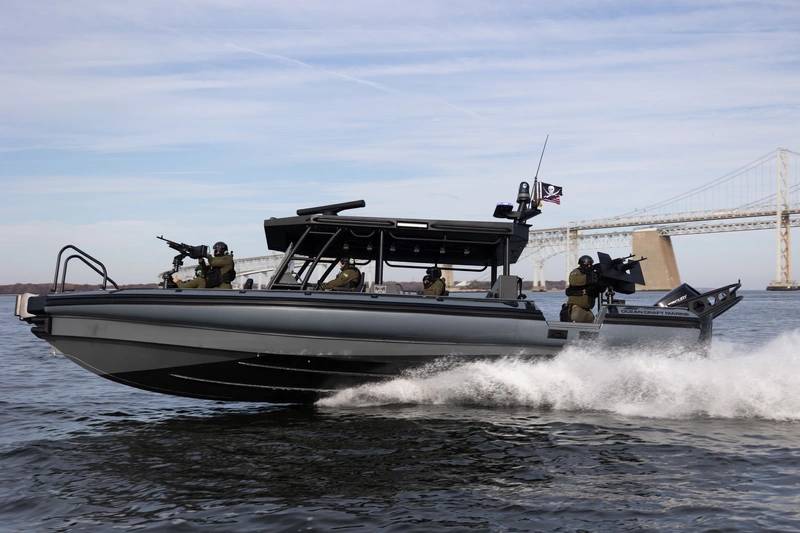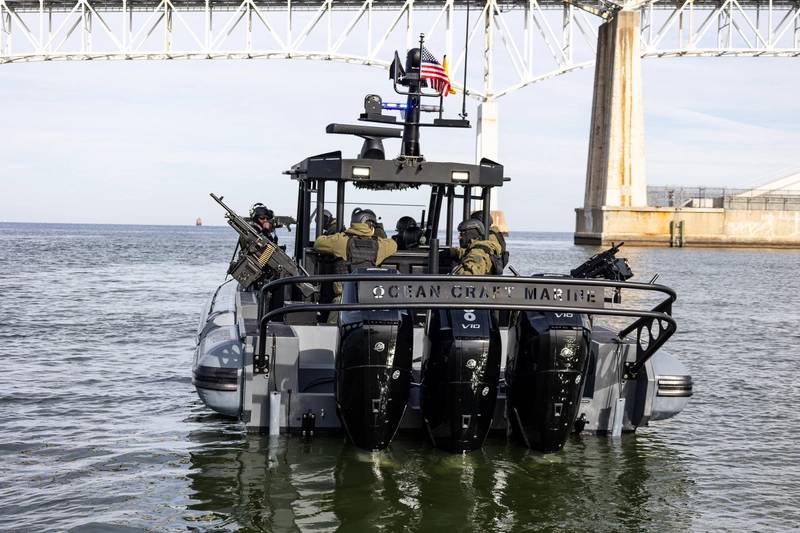Inside Project Perfect Storm
The latest high-tech rigid hull inflatable boat (RHIB) from Annapolis, Md. based boatbuilder Ocean Craft Marine (OCM), the 11.5-meter Offshore Interceptor, is the result of an innovation push involving some of the industry’s top players.
“The design itself is an evolution of existing designs we've done, but taking it to the next level,” said Todd Salus, OCM vice president of operations. “It’s the latest and greatest innovation.”

The company’s founder and CEO, Roy Nouhra, said the boat’s origins trace back a few years to a design OCM developed for a “very secretive organization” within the U.S. Department of Defense, to be delivered as commando boats for a military in the Middle East.
“We got the contract, we developed and delivered the boat and we gave them training,” Nouhra said. “A year later, we gave them another training and learned about their unmet needs, because we didn't have a chance to talk to the end user before. From there, we went back to our drawing table to produce version two of that boat, building on the feedback we got and bringing more innovation into it.”
At this time, OCM established the Accelerator for Innovation in the Maritime Ecosystem (AIME), a platform to collaboratively drive innovation integration, especially within the professional and military segments, but also in other parts of the maritime industry. OCM said it plans to invest more than $250 million over a 10-year period to establish the independent maritime innovation laboratory.
According to Salus, many government customers in the patrol boat space are typically slow-moving in adopting new technologies, and their acquisition processes can be suppressive to innovation. “There’s nothing innovative going on there,” he said. “So, we’re pushing them to innovate.”
AIME is an attempt to break the mold. “AIME is about bringing the best of the industry together with people that are forward thinkers—people that want to push the evolution,” Nouhra said. “It’s a lot of knowledge-sharing with people that, with an open heart, are willing to give the knowledge for the industry to benefit. And we want to all push it together.”

AIME’s first fruit came relatively quickly. Dubbed Project Perfect Storm, the OCM-led initiative brought together companies such as Ullman Dynamics, Porta Performance Products, Skydex, Military Systems Group, Livorsi Marine, Hefring Marine, Structural Composites, TMS Group, TotalSim, Diverse Dimensions and SEA-IT, to produce the state-of-the-art 11.5-meter Offshore Interceptor.
Constructed in aluminum, the boat’s hull offers excellent seakeeping and tactical turning capabilities as well as fast holeshots, according to the builder. Powered by 1,200-horsepower Mercury Marine V10 triple outboard motor configuration (complete with Mercury’s Active Trim System), the boat offers an operational range exceeding 400 miles at 36 miles per hour (mph) cruising speed, and at wide-open throttle it can top out at 64 mph.
The vessel features OCM's hybrid constructed polyethylene closed-cell foam-filled "D"-shaped Collar, with options for heavy-duty Orca 866 Hypalon and Polyurethane finishes.
The boat’s weapon mounts, which feature an articulated swing arm, are designed by Military Systems Group and are a brand-new design created through a collaborative process that saw partners talking with one another to create a new solution, Nouhra said.
This vessel's spacious deck layout is carefully designed and packed with innovation from AIME partners. It features two consoles to optimize division of labor and is engineered to enhance visibility and situational awareness, and t’s also easily reconfigurable thanks to Ullman Dynamics' shock-mitigating seats mounted on deck tracks. The suspension seating and Skydex shock-mitigating flooring system are engineered to boost crew comfort and safety.
“The boat is designed as an offshore interceptor, but it's very appropriate in inland waterways as well. It could just as easily be a police boat in any harbor—there’s even a firefighting variant too,” Salus said, noting the vessel can be built in either open or cabin configuration.
At the end of the day, the goal is to deliver to the customer the best possible boat that fits their requirements, and OCM’s work to incorporate state-of-the-art technologies is part of that mission.
Asked about demand for new RHIBS such as the 11.5m Offshore Interceptor within the market, Salus said, “There are a lot of assets out there that are not only ready to be retired, but that are not performing as advertised and not to the customer's satisfaction. We hear that a lot. They're looking for someone to cure their pains. And we're very good at that. We were very good listeners and we try to give the customer exactly what they need and the performance that they desire.”
“We're coming together in an unprecedented way to incorporate all of the latest innovations into one platform,” Salus said. “And we hope to be an exemplar to our federal customers of what can be done and the innovation that can happen and happen quickly and collaboratively rather than everyone being in their silo and fighting each other. We can work together because we augment each other, we complement each other.”
Critical Comms
Situational awareness is key on board any working vessel, but especially high-speed patrol boats, which routinely encounter some of the world’s harshest and most dangerous environments,
Ocean Craft Marine’s 11.5-meter Offshore Interceptor is equipped with fully integrated a wireless 9100 Digital Marine Communication System from The David Clark Company, which reinforces crewmember interoperability and amplifies mission safety and success, according to the builder.
The Series 9100 is a mission-critical, marinized digital communication system offering unmatched ease of use, programmability, scalability and versatility, with a proven track record in the demanding patrol boat/interceptor market. It’s been chosen for hundreds of installations for the U.S. Department of Homeland Security and U.S. Customs and Border Patrol interceptors, as well as on many U.S. Coast Guard small boat programs and international police, SAR and security vessels in the EU, Middle East and Asia Pacific regions.
OCM said David Clark comms were chosen for:
- Enhanced crew coordination: The wireless system significantly improves intra-crew communication, enabling better coordination and efficiency during operations.
- Situational awareness: With clear and reliable communication, crews can maintain high situational awareness, crucial for safety and effective mission execution.
- Reduction of crew fatigue: The headsets are designed to mitigate the effects of prolonged exposure to wind and engine noise, reducing fatigue and improving overall crew well-being.
- Proven reliability: David Clark Company’s products have a long-standing reputation for durability and reliability, making them a trusted choice in the maritime industry.
- User-friendly design: The headsets are easy to use, allowing crews to focus on their tasks without being distracted by complex communication systems.
- Versatility: This communication solution is versatile and adaptable, making it suitable not only for the OCM 11.5M but also for a wide range of other vessels used in professional maritime operations.
“The [David Clark] wireless headset communication system has been a game-changer for our professional maritime end-users, enhancing crew coordination, crew inoperability, and overall communication capabilities both onboard the boats and externally” Salus said. “These systems greatly increase our situational awareness and our crew’s effectiveness, making it a must-have for any professional boat operations. Furthermore, the headsets greatly reduce crew fatigue from prolonged exposure to wind and engine noise.”
